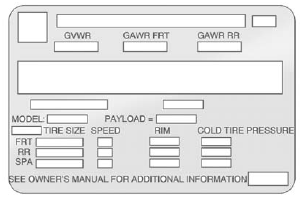Certification/Tire Label

Certification/Tire Label
A vehicle specific Certification/ Tire label is found on the rear edge of the driver door. The label shows the size of your vehicle's original tires and the inflation pressures needed to obtain the gross weight capacity of your vehicle. This is called Gross Vehicle Weight Rating (GVWR). The GVWR includes the weight of the vehicle, all occupants, fuel, and cargo.
The Certification/Tire label also tells you the maximum weights for the front and rear axles, called Gross Axle Weight Rating (GAWR). To find out the actual loads on your front and rear axles, you need to go to a weigh station and weigh your vehicle. Your dealer can help you with this. Be sure to spread out your load equally on both sides of the centerline.
Never exceed the GVWR for your vehicle, or the GAWR for either the front or rear axle.
The Certification/Tire label also contains important information about your Front Axle Reserve Capacity. See “What is front axle reserve capacity, and how do I calculate it?” under Adding a Snow Plow or Similar Equipment on page 9‑113.
WARNING
In the case of a sudden stop or collision, things carried in the bed of your truck could shift forward and come into the passenger area, injuring you and others. If you put things in the bed of your truck, you should make sure they are properly secured.
WARNING
Do not load the vehicle any heavier than the Gross Vehicle Weight Rating (GVWR), or either the maximum front or rear Gross Axle Weight Rating (GAWR).
This can cause systems to break and change the way the vehicle handles. This could cause loss of control and a crash. Overloading can also shorten the life of the vehicle.
Notice: Overloading the vehicle may cause damage.
Repairs would not be covered by the vehicle warranty. Do not overload the vehicle.
Using heavier suspension components to get added durability might not change your weight ratings. Ask your dealer to help you load your vehicle the right way.
If you put things inside your vehicle—like suitcases, tools, packages, or anything else—they go as fast as the vehicle goes. If you have to stop or turn quickly, or if there is a crash, they will keep going.
WARNING
Things you put inside the vehicle can strike and injure people in a sudden stop or turn, or in a crash.
• Put things in the cargo area of the vehicle. Try to spread the weight evenly.
• Never stack heavier things, like suitcases, inside the vehicle so that some of them are above the tops of the seats.
• Do not leave an unsecured child restraint in the vehicle.
• When you carry something inside the vehicle, secure it whenever you can.
• Do not leave a seat folded down unless you need to.
There is also important loading information for off-road driving in this manual. See “Loading Your Vehicle for Off-Road Driving“ under Off-Road Driving on page 9‑6.
See also:
Lane Departure Warning (LDW)
For vehicles with LDW, it is intended to help avoid unintentional lane departures.
It may provide a warning if the vehicle is crossing a lane without using a turn
signal. LDW uses a camera sensor ...
Add-on Electrical Equipment
The OnStar system is integrated into the electrical architecture of the vehicle. Do not add any electrical equipment. See Add-On Electrical Equipment on page 9‑112. Added electrical equipment ma ...
Under the Hood
The Yukon Hybrid uses a two-mode hybrid system. The system augments the SUV's
V-8 engine with two electric motors, both powered by a 300-volt battery pack. A
cylinder-deactivation system cuts powe ...





